Are you a Quiet Speculation member?
If not, now is a perfect time to join up! Our powerful tools, breaking-news analysis, and exclusive Discord channel will make sure you stay up to date and ahead of the curve.
So. Much. Modern. I can barely update the Top Decks spreadsheet fast enough to keep pace! Since May 1st, we've had two Star City Games Opens, over 55 events from the SCG States and Provincial Championships, another batch of 50+ events from TCGplayer's State circuit, and dozens of online and paper tournaments in between. The April metagame update looked healthier than ever, and we still haven't reached the crowning glory of this Modern May-hem: Grand Prix Modern Weekend. Today, we're breaking down the format on the eve of the Grand Prix showdown so you know what you need to beat, what you need to play, and what to expect at the coast-to-coast Modern extravaganza.
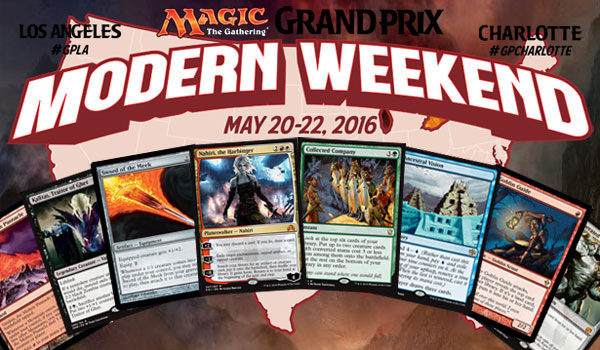
Leading into this weekend, you read a lot of unwarranted hyperbole about Modern. Blue-based control was dead. RG Tron was dead. Abzan Company was unbeatable. Ancestral Vision would render Jund unplayable. Sword of the Meek would invalidate aggro. Almost without fail, all of these overstated and groundless predictions turned out to be wrong. You only need to look at the SCG Indianapolis Top 32 to see just how off-base most Modern pundits were, let alone the April 8 - May 1 metagame breakdown. Instead of succumbing to the popularized panic that so often characterizes Modern articles, we're going to break down the data from over 200 events and almost 2,000 individual decks to equip you for your Grand Prix exploits. Championing my Ad Nauseam in battle? Trying out Nahiri Jeskai Control? Figuring out your Jund sideboard? Sitting at your chair and watching the spectacle on Twitch? No matter how you're enjoying the weekend, today's article will prepare you for what is to come.
[wp_ad_camp_1]
Pre-Grand Prix Tierings
I love the iconic Modern Nexus metagame breakdown as much as the next Nexite, but we have a different order of business today than in our normal updates. Our job is not to describe the international metagame to gauge format health, determine a deck's average positioning, and track changes from one month to the next. Our task today is to see exactly what Modern looks like before the dual Grand Prix and translate that into specific takeaways for choosing a deck, anticipating matchups, and adjusting maindeck and sideboard slots.
To fulfill our pre-Grand Prix mandate, we'll still unpack our Top Decks dataset to identify Modern's three tiers, but we'll analyze them to pinpoint specific Grand Prix marching orders. Should you play Deck A? Should you swap Card X for Card Y? Should you expect Deck B and ignore Deck C? These are the kinds of questions we'll aim to answer today. For each tier, I'll list out the decks in that segment and then give some overall takeaways across the different strategies.
In describing Modern's Tier 1, 2, and 3 decks, we'll draw on the recently updated Top Decks spreadsheet with its over 170 paper events (comprising about 1,300 decks) and 34 tournaments from Magic: The Gathering Online (spanning north of 350 lists). We'll join our paper and MTGO data with Day 2 breakdowns from both SCG Milwaukee and SCG Indianapolis, along with the Top 16 results from both major tournaments. Our Top decks page explains the math and statistical methods we use to combine all those numbers into actual tierings, as well as the weighted and adjusted "Overall Metagame %" shares.
Current Tier 1 strategies: decks to beat
Thinking about the Grand Prix, Tier 1 decks are the strategies you should expect to play against at least once over the course of Days 1 and 2. You might not play against all of these decks over the course of the tournament, but you are all but guaranteed to play against at least half of them. That's doubly true if you hit Top 8, where you should expect at least 50% of the Top 8 to consist of Tier 1 decks. You'll need both specific sideboard cards for these matchups, as well as a clear understanding of your deck's role and play in each of the Tier 1 matchups. Haven't decided on a deck yet? Any of the Tier 1 contenders are good options.
Tier 1: 4/8/16 - 5/16/16
Our April breakdown tackled the Tier 1 strategies deck by deck, and that's roughly the same approach we'll lean on today. This will give you a sense of which Tier 1 decks have better positioning than others and how you want to build your deck to prepare for Tier 1 contenders.
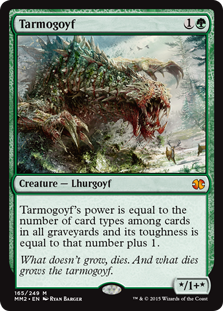 Jund (8.7%) is the safest interactive bet
Jund (8.7%) is the safest interactive bet
The BGx mainstay sticks around at the top yet again! If you aren't sure what to play and want to go interactive, it doesn't get more reliable than Jund. In even the toughest matchups, you can leverage the powerful BGx core (and your tailored sideboard bullets) to eke out small margins. In the average matchup, you're the 53% favorite, to quote Brian Bruan-Duin. As for your good matchups and when mopping up Modern's sub-Tier 2 fringe, you have at least a 60-40 edge across the field. Not playing Jund? Make sure you can kill or race Tarmogoyf, and make sure your synergies aren't shredded by efficient disruption.
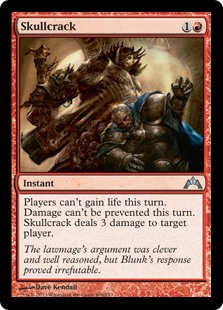 If in doubt, Burn (6.2%) 'em
If in doubt, Burn (6.2%) 'em
If Jund is the safest interactive choice for the Grand Prix, Burn is the safest overall. It's fast and linear: whether you're facing Tier 1 Nahiri or a Tier 3 Tooth and Nail, "Bolt the face" tends to remain the gameplan. It's consistent, which means you're less likely to stumble on bad draws and more likely to deliver over 15 rounds. If you have no idea what to play, Burn is forgiving and, although hard to master, easy to learn. Sure, you'll sometimes lose to Kitchen Finks, but your opponent just needs to flub one draw step for you to win.
All that said, Burn does not have the best positioning among top-tier aggro (people expect it and the Jeskai uptick hurts), but it's still a great choice if you're lost. If you need to beat Burn, either win on turn three or try to maindeck some form of lifegain like Finks, Lightning Helix, Huntmaster of the Fells, or Kalitas, Traitor of Ghet.
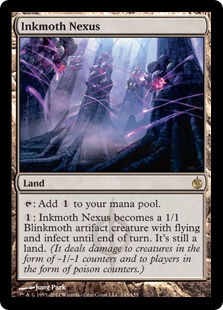 Roll the dice on Infect (6.1%)
Roll the dice on Infect (6.1%)
Grishoalbrand is wallowing in Tier 3 misery. Most Burn and Zoo decks are geared towards turn four instead of turn three, and Affinity has the worst positioning in years. This leaves Infect as the fastest top-tier strategy still standing. Because the Grand Prix are going to be so diverse, Infect is poised to sneak wins while everyone else is worrying about assembling Urzatron, grinding the mid-game, or sending Wild Nacatls into the red zone a turn too slow. Unfortunately, traditional UG Infect struggles against both Abzan Company's toolbox and Jund's, Burn's, and Jeskai's removal: I'd gamble on Phyrexian Crusader and a BG Infect list like Alex Zurawski's. When beating Infect, remember to combine removal with clocks unless you want Infect to topdeck a win from nowhere.
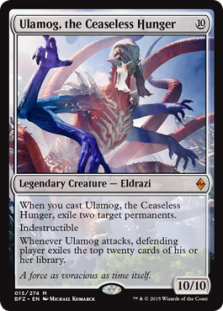 Respect RG Tron (6%)
Respect RG Tron (6%)
Hopefully, none of our readers run in the "Tron is dead" crowd. We've buried that myth every week since SCG Milwaukee and the Grand Prix shouldn't overturn that trend. There's a chance Moderners still buy this fantasy and yet again forget Crumble to Dusts and Fulminator Mages, but it's unlikely. We saw a similar narrative last year, with Tron rising before Charlotte 2015 and big-mana busters fighting back at the Grand Prix itself. Expect Ulamong and friends to perform, but also expect players to be ready. Tron players: you'll have fewer freebies but will still prey on lingering doubters. Tron haters: don't be a dupe and do include your 3-4 Tron countermeasures, especially if you're on the Jeskai hype train.
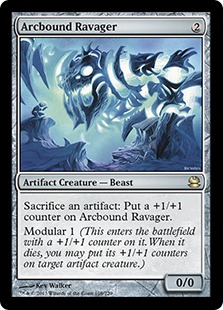 Affinity (4.6%) is not where you want to be
Affinity (4.6%) is not where you want to be
Between spot removal, sweepers, Company and Chord toolboxes, and extensive artifact hate, Affinity is in a bad place. Jeskai Control hitting Tier 1 is a real disaster for the deck. Kiki Chord's and Abzan Company's rise also stings. To make matters worse, the Grand Prix aren't far enough from Milwaukee and Indianapolis that players are likely to have simply forgotten Affinity in a few days. Unless you're a Frank Karsten master of Affinity, stay away. People will start forgoing Ancient Grudges and Stony Silences soon enough, but it's unlikely to happen this Saturday. Affinity opponents: don't be afraid to tweak an anti-Affinity slot or two.
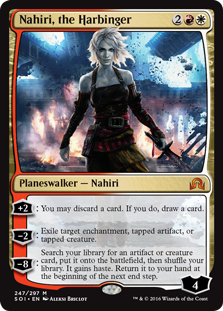 #Hype. #Nahiri. #JeskaiControl (4.5%)
#Hype. #Nahiri. #JeskaiControl (4.5%)
Love her or hate her, Nahiri, the Harbinger heralds a new era of blue-based control. Her flavorful combo with Emrakul, the Aeons Torn gives control a proactive and imminent win condition, and although she's no Splinter Twin, the planeswalker definitely fills a critical archetype gap. It's a testament to Nahiri's power that Peter Ingram's SCG Indianapolis-winning list is basically 2014 Jeskai Control plus five cards.
The #Nahiri hype is massive (#CleganeBowl-massive <-- VERY NSFW) and this is going to translate to lots of Jeskai during the Grand Prix. Even if you think the deck is bad (results suggest the opposite), you must still respect the #Hype and still prepare for #Nahiri. After all, if you can stop Nahiri herself, whether via Maelstrom Pulse or Pithing Needle, you just need to beat boring old Jeskai.
 Under the radar with Scapeshift (4.4%)
Under the radar with Scapeshift (4.4%)
To be clear, this decktype includes blue-based Temur and Bring to Light variants, not the RG Primeval Titan builds we see under "Titan Shift" in Tier 2. This confusion underscores Scapeshift's positioning in Modern. It's got solid Tier 1 stats going into the Grand Prix, even jumping .6% since May 1, and yet most people don't have it in their sights. Of the eight Tier 1 strategies, it's the one most would consider as Tier 2, or confuse it with the higher-profile, worse-finishing Titan Shift. Scapeshift pilots can abuse this by pairing a Scapeshift combo finish with Cryptic Command and Snapcaster Mage control. Scapeshift opponents can prepare with ample hand disruption, a fast clock, or pressure paired with modest disruption.
 Abzan Company (4.1%): viable but overblown
Abzan Company (4.1%): viable but overblown
As I wrote about in my April update, it was the "right time" and "right place" for Abzan Company, but I did not expect its reign to last. Most Modern commentators reactively pegged it as the deck to beat, an unwarranted characterization that has fallen flat since. Abzan Company exploited metagame holes and those holes have largely closed, especially with Tron's continued presence.
That said, Company's SCG Indianapolis performance surely under-represents its true viability, so don't ditch or ignore Team Melira just because it sent zero pilots to Indy's Day 2. I rank this as a decent choice going into the Grand Prix, but not the format king many inaccurately identified. Don't overprepare with Grafdigger's Cages. Your Anger of the Gods will be enough.
I wouldn't get into this level of detail for most Grand Prix, but given the evolving nature of the post-April 4 Modern and the dual, coast-to-coast tournaments, there's a lot at stake for the format and format specialists. This Tier 1 breakdown won't necessarily point you to or away from one deck (unless that deck is Affinity), but it will give you all the context you need to have the best shot possible at navigating the weekend metagame.
Current Tier 2 strategies: decks to play
In our normal metagame updates, Tier 2 decks are the strategies you might encounter at a given event and those you should enjoy success with. This is also true during Grand Prix weekend, but I want to take that a step further in both directions. On the expectation front, you should not 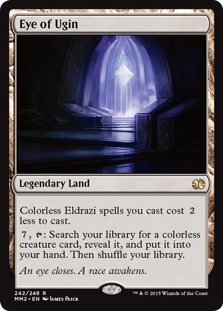 necessarily expect to play against all of these strategies, although I would still devise a plan for beating them. You'll also still want to know how they win and what cards they play so you aren't caught off-guard by a Kiki Chord trick or the RG Eldrazi pilot who missed the Eye of Ugin memo. On the playability front, don't think of these as fringe alternatives to the Tier 1 options. Rather, consider these as serious under-the-radar contenders which have a shot at Top 8 glory.
necessarily expect to play against all of these strategies, although I would still devise a plan for beating them. You'll also still want to know how they win and what cards they play so you aren't caught off-guard by a Kiki Chord trick or the RG Eldrazi pilot who missed the Eye of Ugin memo. On the playability front, don't think of these as fringe alternatives to the Tier 1 options. Rather, consider these as serious under-the-radar contenders which have a shot at Top 8 glory.
People are not expecting these decks and won't prepare for them. This makes many Tier 2 decks excellent choices for the Grand Prix. In fact, and you can quote me on this, I'd go so far as to say some Tier 2 choices are actually better-positioned than Tier 1 staples going into the weekend.
Tier 2: 4/8/16 - 5/16/16
Repeat: if you know how to play a few of these decks, play one at the Grand Prix. Most people are going to have Tier 1 strategies in their mind when they select their 75. For those who know a certain Tier 2 deck inside and out, the metagame has already proven your strategy exceeds a playability baseline. It will just be up to you to wield it in on the Grand Prix floor.
Instead of taking Tier 2 one deck at a time, I'm going to highlight three strategies I have my eye on for the weekend.
 Kiki Chord (3%)
Kiki Chord (3%)
Remember the Nahiri, the Harbinger and Abzan Company hype in Tier 1? Kiki Chord combines elements of both into a potentially breakout competitor at the Grand Prix. Lists like Nicholas Davis' 10th place build at Indianapolis highlight this potent strategic mix. The Hoogland specialty combines midrange Pia and Kiran Nalaar/Restoration Angel value and a Kiki-Jiki, Mirror Breaker combo kill (now from multiple angles courtesy of Nahiri), all built around a Chord of Calling toolbox. Kiki Chord's metagame share hasn't changed much since May 1, but its Indianapolis finishes and Nahiri-centric hype make it a solid pick for Grand Prix weekend.
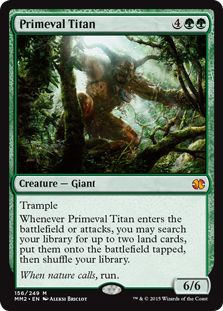 Titan Shift (2.7%)
Titan Shift (2.7%)
Despite only a modest uptick in the standings (+.5% since May 1), Titan Shift has been getting a lot of attention on stream, in articles, and across the Modern community. Daniel Hendrickson took a Through the Breach-powered variant to 3rd place at SCG Indy, with Adam Liu going 11th at the earlier SCG Milwaukee on the Scapeshift version. Between online buzz, these discrete Top 16 finishes, the deck's upward metagame trend, and its punchy mix of linearity and interaction, Titan Shift has the trappings of a breakout Tier 2 contender at Charlotte and Los Angeles.
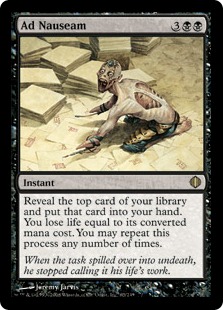 Ad Nauseam (2.5%)
Ad Nauseam (2.5%)
I'm not just highlighting Ad Nauseam because I have my Spoils of the Vault 75 sleeved up on my desk at all times. Rather, I legitimately believe Modern's last "true" combo deck is an excellent choice for the weekend.
One of Ad Nauseam's biggest strengths is instant-speed timing. Many Modern opponents are committing to turn 4-5 bombs like Nahiri, Titan, Company, Scapeshift, etc. Ad Nauseam and Angel's Grace in response seals the game quickly. Moreover, many of those same decks are preoccupied with spot removal and sweepers, with hard countermagic few and far between. The combo strategy blanks most removal and can play through countermagic off its huge mana reserves, which means opponents can't even safely wait to deploy threats with counter backup. Added bonus: Grace and Phyrexian Unlife are spectacular against most aggressive strategies. Darien Elderfield lived the Ad Nauseam dream at Charlotte 2015, so here's hoping for an encore a year later.
That's not to say these are the only Tier 2 options or even the best. Elves, for example, combines elements of Infect's turn three win, Abzan Company's board-restocking and flexibility, and Gruul Zoo's and Affinity's aggressive width. Elves veterans can leverage this to have a good Day 1 and Day 2 at Los Angeles and Charlotte.
When considering other Tier 2 decks, make sure you aren't playing a worse version of a Tier 1 strategy. If you have any doubts, go with the Tier 1 option instead. For instance, Grixis and Eldrazi do have legitimate strengths and unique characteristics over Jeskai and Tron respectively, but the overall metagame context is more favorable to the latter than the former. Unless you're planning to pull a Chapin or a Thompson, stick with the Tier 1 fallbacks in these cases.
Current Tier 3 strategies: decks to avoid or abuse
Repeat after me: "I will not audible to a Tier 3 deck." In fact, you will also not even play a Tier 3 deck unless you have extensive experience with it going into the Grand Prix. Sorry. Starting to put in your Storm or Goblins reps today is not going to cut it. On the plus side, all of these decks 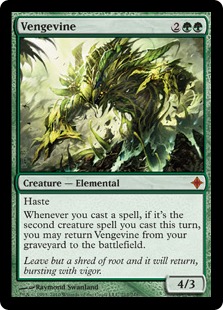 aren't just under the radar like Tier 2. They are off the map entirely, so if you know your Tier 3 strategy, you can steal serious percentage points just from opponents having no clue how to beat you. Or going on tilt when they lose to you in Game 1.
aren't just under the radar like Tier 2. They are off the map entirely, so if you know your Tier 3 strategy, you can steal serious percentage points just from opponents having no clue how to beat you. Or going on tilt when they lose to you in Game 1.
On the minus side (the stronger side of the equation), there are metagame conditions which prevent these decks from reaching Tier 1 or Tier 2 status. Stated another way, these might just be bad decks. If you play a Tier 3 deck, you are basically gambling that your experience with the deck is enough to outweigh its internal and contextual weaknesses. I won't judge you if you're claiming to be the world's foremost Dredgevine or RW Lockdown expert, but make sure you can back up your claim with actual experience. And even then, some of these decks might just be bad...
Tier 3: 4/8/16 - 5/16/16
See your list on that table? Time to ask yourself if you think you're a real prodigy on the list because if the answer is "no," keep Mr. Goblin Electromancer at home. Tier 3 lists are much more viable at the local level, where you can dodge bad matchups over five rounds and write off an 0-4 Friday Night Magic as bad luck. You don't get that luxury over the Grand Prix weekend, which makes Tier 3 candidates much less attractive.
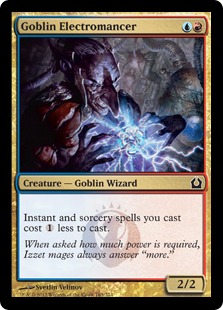 To be very clear, this is not a knock against unfair, linear, non-interactive decks. There's a myth in Modern that such "inconsistent" decks are bad choices for long tournaments, but that neither plays out mathematically or in practice. It's also not a jab at fringe decks: some Tier 2 mainstays started in Tier 3 before climbing the ranks. Rather, it's a strike against unfair, linear, non-interactive decks a) that are Tier 3 and b) in a Grand Prix setting. Want to play linear Infect this weekend? Go for it. Want to roll with UW Tron at your FNM? Be my guest. Thinking of bringing Storm, Temur Midrange, or Lantern Control to Charlotte or Los Angeles? I hope you got your reps in or you'll have a bumpy few hours on Day 1.
To be very clear, this is not a knock against unfair, linear, non-interactive decks. There's a myth in Modern that such "inconsistent" decks are bad choices for long tournaments, but that neither plays out mathematically or in practice. It's also not a jab at fringe decks: some Tier 2 mainstays started in Tier 3 before climbing the ranks. Rather, it's a strike against unfair, linear, non-interactive decks a) that are Tier 3 and b) in a Grand Prix setting. Want to play linear Infect this weekend? Go for it. Want to roll with UW Tron at your FNM? Be my guest. Thinking of bringing Storm, Temur Midrange, or Lantern Control to Charlotte or Los Angeles? I hope you got your reps in or you'll have a bumpy few hours on Day 1.
Tier 1 and Tier 2 decks, linear, unfair or otherwise, have a baseline metagame share to suggest they can execute their gameplans and win. Tier 3 decks do not meet this benchmark because there is a fundamental misalignment between their strategies and the current format context. Only play them if you know their ins and outs like Kibler knows his Wild Nacatls.
Charlotte, Los Angeles, Modern, and You
As a data-driven Modern player, one of my hardest challenges is using format-wide data to inform decisions for specific events. One moment, you've put in some reps, crunched the matchups and shares in Excel, and picked the perfect deck. The next moment, you're down a game in round three after going 0-2 to your two worst matchups. That's Modern for you, but more importantly, that's Magic and that's life. The key here is not to question your critical selection method just because you bombed out on a smart choice like Jeskai Control. Perhaps you should have audibled to Goblins and ignored the data, but it's much more likely you should have read the numbers differently, made small deckbuilding shifts, and adjusted your gameplay over those early rounds.
I'll be up and down from my computer all weekend, so as much as I'd love to live-Tweet the action, we'll have to save that coverage for another Grand Prix. That said, I'll be around Twitter and the comment sections as much as I can, so shoot me a note if you have any questions or want to talk Modern. Same thing goes for your preparations for the Grand Prix: if I didn't address a specific card or deck, come find me in the comments.
Thanks for reading and brace yourselves for one of the most epochal moments in Modern tournament history: the post-Twin, post-Eldrazi, post-Vision/Sword/#NahiriHypeIsReal Grand Prix Weekend. See you all after the dust has settled and enjoy the weekend show!





I love how BW Tokens has completely fallen off the map despite its 50/50 or better matchups vs at least half of the top tier decks.
I believe this is because of the deck’s relatively low power-level, or at least the perception of a low power-level. Players want to do powerful stuff in Modern and attacking with pumped Spirit tokens doesn’t feel very powerful. It’s also possible BW Tokens’ theoretical strengths aren’t actually that good in practice, but we’ve seen breakout performances by the deck before, so it could happen again.
Agreed, also I often have to explain to people that tokens isn’t an aggro deck, there seems to be this idea that decks that play/create a lot of creatures must be aggressive. Tokens is inherently a midrange deck, and a meta deck. Additionally you can’t really pick it up and play it, it requires a lot of experience to be even decent with it. Too bad for me that the GPs this weekend are way too far for me to get to, otherwise I’d bring mine and see how it fares, states wasn’t horrible, missed prizes by one match, finished in the top 3rd of the field.
I think Sheridan made a bet with someone to see how many May-hem puns he could fit into his articles. . .
Great stuff. Printed out the top decks spreadsheet and will be pondering over it all day. This site is the best!
MY SECRET PLAN IS REVEALED! (I promise people will only have to endure one more in next week’s recap article…)
Glad you enjoyed the analysis and hope the spreadsheet is useful! Lots to process for the weekend.
On Nahiri:
I haven’t seen such bad card evaluation on SCG with the express purpose of influencing the market since they were trying to convince people that Purphoros was worth 30$. The only thing she did is to give Jeskai Control a reliable finisher, just like Tasigur/Angler did with Grixis.
Basically, don’t forget your Crumples and your Stony Silences/Ancient Grudges or you are going to have a bad time.
I was particularly unhappy with Tom Ross’s discussion about Nahiri in his Fact or Fiction contribution. It was hyperbolic, unsupported, extremely premature, and embodied everything about the worst kind of Modern ban mania. The other hype is equally problematic; it’s rare to find measured, critical, and nuanced opinions in Modern content these days.
I’ve been eagerly awaiting this article, and it delivered according to expectations. Some thoughts:
1. I think your Tier 1 breakdown was very comprehensive, and I understand that Tier 2 is a bit too broad to get similar treatment. However, I’d like to get your thoughts on Death & Taxes (whose BW Eldrazi version is on the same hype train as Nahiri Jeskai Control is). Do you expect it to retain its current place in the meta, or do you think its presence (which is higher than I ever remember it being in Modern) is unsustainable?
2. Speaking of presence, where are all the Merfolk players? Affinity is at its lowest share in ages, and we have game or are favored against every other matchup in Tier 1, and most of what’s in Tier 2 (with Elves and Titanshift being the shaky ones). I know we had that bug for Kira, Great Glass-Spinner on MTGO driving down our meta share (and it’s clear we still haven’t quite recovered from that), but this is as Fish-friendly a meta as I think I’ve ever seen.
3. Going back to the vestiges of the Eldrazi menace, I’m frankly rather surprised (and impressed) that it still command a Tier 2 meta share right now. I know that it reinvented itself to some extent by going more “big midrange” in the vein of adding Tron lands and/or more early-game interaction, but usually the “this just got nerfed” stink sticks around with a deck for at least a couple of months. Are you surprised that so many pilots have stayed the course? Because I am.
Looking forward to hearing from you on these.
Speaking to the Fish question, I’ve been off Fish recently due to poor results stemming from Ancestral Vision inducing players to play slow control decks with Supreme Verdict. Prior to the unbanning my plan against decks like that was to attrition them out and then counter Sphinx’s Revelation for the win but Vision has made that much more difficult. I don’t know how applicable my experience is to the rest of the metagame, but I think that Fish is in a transition period right now while we adjust to the increased presence of control. Once things settle down and/or a better plan for that matchup is found Fish will be lower than it arguably should be.
Once again, your experience differs from mine. The Jeskai bug has bitten folks in my metagame as well, and I can’t say I’ve had all that much trouble with them. The “pressure them with 2-3 Merfolk and reload as necessary” plan is tried and true, and it still works. That said, it’s probably more punishing to decks like your variant (which has ~24 creatures) as opposed to mine (which runs 28+, with more in the board).
Jeskai isn’t the problem, Kira is still very good there and the old plan still works against them. Visions draws them about the same number of cards as the older cantrip heavy versions did so that matchup hasn’t changed. It’s straight UW that has been trouble because they usually have the full set of Verdicts and around here a few Wraths maindeck as well and follow that up with Elspeth. In that matchup you must respect their clock, unlike Jeskai, and the fact that they can and will just drop bomb after bomb and stick a win condition once you’ve run out of steam makes things very difficult. I’m not sure yet how to deal with that since trying to aggro them out before Verdict kills you is unlikely, but the attrition plan isn’t effective against Elspeth.
You’re right – WU is definitely tougher for us, because it relies more on uncounterable sweepers (ouch) and slamming down Planeswalkers (double ouch). However, it’s not as good as Jeskai is against the field (Gruul Zoo in particular is a problem, since a T4-5 Verdict can be too late to save them), and it doesn’t have access to the Nahiri flavor-of-the-month combo, so I wouldn’t expect to see much of it.
However, if you do, I’ve had the most success by changing up my keep/mull decisions (if I don’t have a T4 goldfish kill or counterspells, I’m probably shipping it), and playing my hand out a bit more like a tempo deck. Supreme Verdict might not be counterable, but Elspeth is, and if you can keep her off the table, you have a chance. It’s a very skill-intensive for sure, but I don’t feel it’s bad (at least, not bad the way Affinity and Elves can be).
1. It feels sustainable. Death and Taxes (aka Eldrazi and Taxes or however you want to call it) is a mix between Tier 0 Eldrazi elements and Tier 2-3 D&T elements. Just from my own experience with both decks, it feels reasonable to believe the combination would land somewhere in permanent Tier 2 contention.
2. A large part of it is the MTGO bug. Paper Merfolk are at 4.3% and MTGO is at .8%, so even with the weighting formula, it’s a big hit for the fishes. I think another reason is the perception that Affinity is still huge, so players aren’t showing up to events with Merfolk. One reason to believe this is that Affinity is really getting hammered right now, which means players are prepared for it in sideboards and taking it seriously, thus indicating an overall expectation of Affinity. I think we’ll start seeing more Merfolk when people start realizing how Affinity is struggling.
3. I am not too surprised because big-mana decks have a history of being excellent in no-Wasteland Modern. There’s also a momentum thing here where players want their Eldrazi Winter investment to stay viable. Overall, I think Eldrazi is currently a bit over-represented and I expect it to stay where it is or fall.
I’m sure someone at my FLGS will adopt some form of Nahiri deck, which makes me giggle at the fact that my latest brew is maindecking multiple Pithing Needles.
Meanwhile, I’m in that awkward place of having one copy of a card that just spiked beyond my budget: do I sell/trade it, give up hope of ever using it, and count my blessings for having at least gotten some value out of the deal? Or do I hold it, hope that it drops, and see if I can scrimp and save enough to get the multiples required for actually playing it? Ugh.
I’d sell it after the GP weekend, when it inevitably spikes over $50. Price memory is big in Modern, and I don’t see her falling under $30-$35 for the foreseeable future. But great call on maindeck Needle! That’s a sweet Modern gem.
Dear Mr. Lardner,
Have you ever had that moment when you’re trying out a new deck and realizing that it absolutely crushing every deck out there?
Yes! That’s how I felt when I first played the new Rhino versions of Pod. The deck was significantly better than the pre-Rhino versions and it felt very unfair.
As a Kiki-chord pilot heading into this weekend, I’m seriously considering cutting my 1 sb Kataki in favor of something like Magus of the Moon. Is Affinity really that poorly positioned where I can get away with just relying on spot removal/Pia & Kiran to grind out the match?
Anyway, great article as always. your metagame analysis is what keeps me coming back to this site <3
Jund is #1 and almost all are main decking multiple kolaghans command.
The thopter sword is going to be around
And control is fairly dominant.
If you don’t have more than one artifact sideboard slot I would not cut it but if you have a few, shaving one off i think is fine
That seems very risky. People are going to be playing Affinity this weekend and Kiki Chord is in an enviable position where it just needs to play that single slot to be prepared. If you were on something else with 3-4 slots, then you could shave one and be okay, but you really want that one bullet for the Tier 1 deck.
That’s kind of what I was expecting you to recommend. Since I’m also packing 2 Stony Silences and a Ghostly Prison, I imagine cutting one of those 3 would be the more conservative swap. Thanks for the feedback!
As an Ad Nauseum player I’m slightly concerned about the large share of Infect. What 75 would you sleeve, in particular what sideboard? I’ve seen crazy stuff like 4 gut shot, 4 lose hope but that seems rather extensive. Is it enough going with 3 fog effects and a couple slaughter pacts? Abzan/jund with their lilianas can also be a struggle but leylines help most of the time.
Yep, Infect is blah. 7 slots, like Ryan committed at Indy, is excessive, but I would go with 4 just in case. I expect people are going to bring BG Infect to try and sneak under the Jeskai removal suite, which makes some of the removal significantly worse (Pact and Gut Shot don’t hit Crusader). I’d go some split of Darkblast and Darkness/Holy Day, and you can go up to 5 slots if needed. Do not pack fewer than 3 Leyline either.
One critically important concept that people may not think about sometimes is that even when unflavored in th meta
If an established deck has been around for a long time such as affinity
On paper do not expect significant numbers decrease in their attendance
Their success rate may drop massively and their day 2 share may be small but you still have to fight through them day one
Especially at an event like a Grand Prix which at least 1/3 (about a thousand players) are only moderately competitive and just there for fun.
They will just bring their personal favorite regardless of the meta
Do not mistake day 2 success at scg events for an accurate display of day one deck density at a gran prix!
Agree! Most players, especially as a function of the Day 1 field, are just going to bring whatever they are good with. Or what they think they are good with. Or what they own. Or what they enjoy! It’s going to be a very diverse metagame, which is why I suggest people just prepare for all the Tier 1 matchups even if the shares are more favorable to some than others.
“If you play a Tier 3 deck, you are basically gambling that your experience with the deck is enough to outweigh its internal and contextual weaknesses.”
Full disclosure I have played multiple decks that are currently listed in your tier 3 section. That said, however, isn’t this description not entirely correct? The tiers as I understand them are based upon the meta-game percentage which generally correlates to how good the deck is but by no means is the sole metric that should be used to determine the play-ability of any deck.
Its entirely possible that any of those tier 3 decks could be far over performing against the current metagame but the overall number of pilots is small enough to keep it under the radar.
Furthermore, with all the net-decking trends that seem to define modern in recent years it seems beyond reasonable to me that if even if a version was doing so well it wouldn’t actually gain popularity until it goes ‘viral’ thus convincing enough people to transition over and then change its status in the Tier system.
Aside from that I very much enjoyed your article though I’m interested to hear your thoughts on that.
-Josh G
It’s possible that a Tier 3 deck could rise to Tier 2 or even Tier 1 status. It’s just not very common (most Tier 3 decks stay Tier 3 for a long time), and is not a great bet for a Grand Prix. For instance, Amulet Bloom started as Tier 3 before exploding into Tier 1 over 6-8 months. The best Tier 3 decks tend to make that shift because they are very good and don’t stay secret for long. But most Tier 3 decks never do, and that’s often not because they are hard to play, under the radar, or unpopular. It’s because they aren’t very good. Not all Tier 3 decks, mind you (there’s always another Amulet Bloom lurking out there), but the vast majority.
Any thoughts about Wilted Abzan being viable again?
With this many Jund’s,burns and “fair” decks in the field, feels like a nice gamble to me.